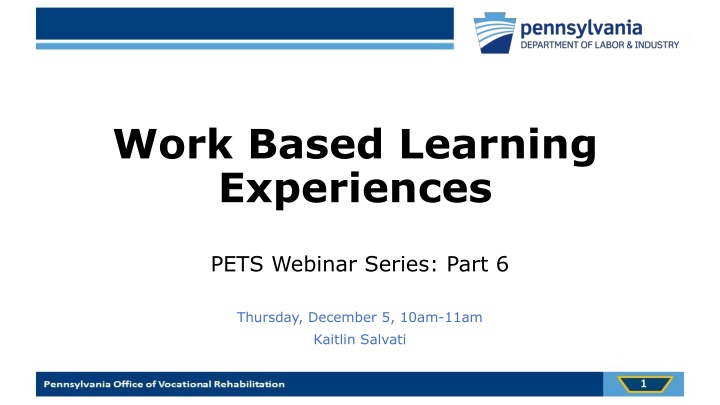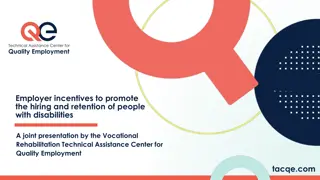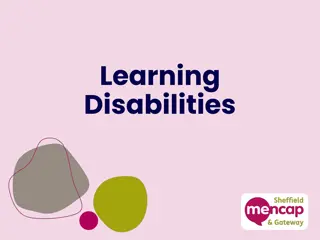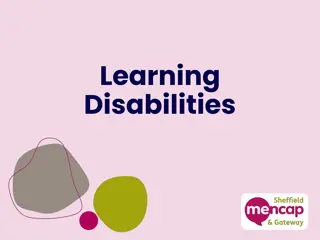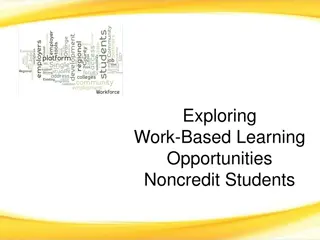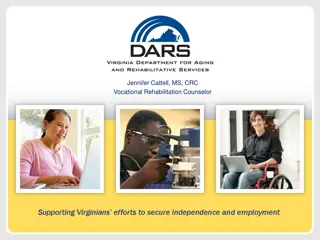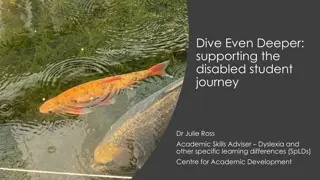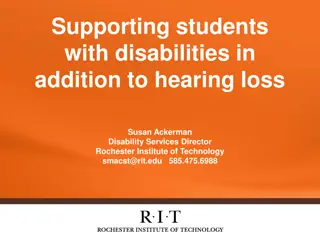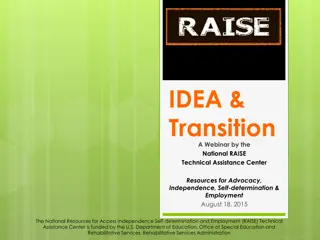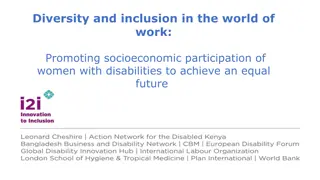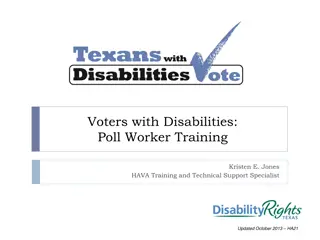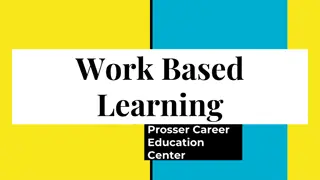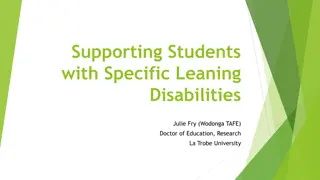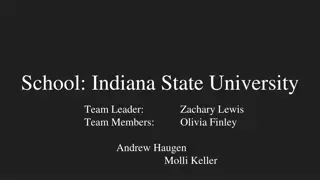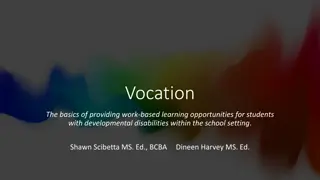Enhancing Work-Based Learning Experiences for Students with Disabilities
Explore the importance of Work-Based Learning Experiences (WBLE) for students with disabilities, learn about resources and documentation methods, understand the role of the Office of Vocational Rehabilitation, and delve into the impact of Pre-Employment Transition Services (PETS) mandated by WIOA. Discover the 5 required PETS and how they contribute to self-advocacy, job exploration, workplace readiness, and more. Gain insights into PETS collaboration with LEAs and individualized Vocational Rehabilitation services to support individuals with disabilities in achieving competitive integrated employment.
Download Presentation

Please find below an Image/Link to download the presentation.
The content on the website is provided AS IS for your information and personal use only. It may not be sold, licensed, or shared on other websites without obtaining consent from the author.If you encounter any issues during the download, it is possible that the publisher has removed the file from their server.
You are allowed to download the files provided on this website for personal or commercial use, subject to the condition that they are used lawfully. All files are the property of their respective owners.
The content on the website is provided AS IS for your information and personal use only. It may not be sold, licensed, or shared on other websites without obtaining consent from the author.
E N D
Presentation Transcript
Work Based Learning Experiences PETS Webinar Series: Part 6 Thursday, December 5, 10am-11am Kaitlin Salvati 1
OVR Mission Statement The Office of Vocational Rehabilitation (OVR) To assist Pennsylvanians with disabilities to secure and maintain employment and independence. 2
Objectives Participants will be able to: Explain why and how Work Based Learning Experiences are provided to students with disabilities Describe resources for providing Work Based Learning Experiences Explain how best to document the provision of Work Based Learning Experiences by OVR staff 3
WIOA The Workforce Innovation and Opportunity Act (WIOA) amends the Rehabilitation Act of 1973 and now requires vocational rehabilitation (VR) agencies to set aside at least 15% of their federal funds to provide Pre- Employment Transition Services to students with disabilities who are eligible or potentially eligible for VR services. 4
5 Required PETS What are the 5 Required Pre-Employment Transition Services? Self-Advocacy Instruction Job Exploration Counseling Workplace Readiness Training Counseling On Postsecondary Options Work Based Learning Experiences 5
Review of PETS and VR Services PETS provide a generalized early start to work based learning experiences. PETS assist students with disabilities in identifying career interests that may be further explored through individualized Vocational Rehabilitation services. PETS must be provided or arranged in collaboration with LEAs. The goal of both PETS and individualized Vocational Rehabilitation services is assisting individuals with disabilities to prepare for and achieve competitive integrated employment. 6
Topics and Outcomes To ensure the quality of our services and accurately record PETS data for RSA reporting, we have also developed a list of topics and potential outcomes. These topics and outcomes should be documented in CPNs or in the Notes section of PETS rosters. 7
Work Based Learning Experiences Definition, intended outcomes, and service format 8
Definition Work Based Learning Experiences use community workplaces to provide students with disabilities the knowledge and skills that will help them connect school experiences to real-life work activities and future career opportunities. 9
Work Based Learning Topics Employer Mock Interview Workplace Tour Informational Interview Individual/Group Shadowing Work Experiences 10
Employer Mock Interview Potential Outcomes: Identify soft skills to be successful at the job or on an interview Demonstrate ability to conduct themselves in a professional manner at an interview Connect school instruction to a real job 11
Workplace Tour Potential Outcomes: Observe employees perform their work duties at their place of employment Identify work tasks of the job Identify job-related skills Demonstrate ability to conduct themselves in a professional manner on a worksite 12
Informational Interview Potential Outcomes: Learn about the culture of a potential workplace from an employed professional Identify work tasks of the job Identify job-related skills 13
Individual/Group Shadowing Potential Outcomes: Observe an employee perform their work duties at their place of employment Identify work tasks of the job Identify job-related skills Identify soft skills to be successful at the job Demonstrate ability to conduct themselves in a professional manner on a worksite Connect school instruction to work experience preparation 14
Work Experiences Potential Outcomes: Identify and apply to jobs of interest Participate in job interview (provider assist as needed) Engage with employers Complete a work experience in a community setting Identify and practice work appropriate behaviors Observe and participate in work tasks in a chosen job environment Connect school instruction to real life work activities 15
Service Format (1 of 4) Individual Services: OVR staff may connect with employers to develop or provide follow up for individual eligible students who are participating in a Paid Work Experience, Community Work Instruction (CWI), On the Job Training (OJT), or Group/Individual Shadowing. Individual services may occur in-person, over the phone, or through other means like Skype It may occur once or be a series of meetings 16
Service Format (2 of 4) Other Individual Services: OVR staff may arrange for Informational Interviews for eligible and potentially eligible students. This service must include community employers, and may occur in-person or via technology 17
Service Format (3 of 4) Group Presentations: OVR staff may arrange for Employer Mock Interviews for groups of eligible and potentially eligible students. Group presentations must include community employers, and may occur in-person or via technology It may occur once or be a series of meetings 18
Service Format (4 of 4) Purchased Services: OVR staff may purchase Work Based Learning Experiences for eligible and potentially eligible students from PETS Providers. Group/Individual Job Shadowing Community Work Instruction Paid Work Experiences * Some administrative memos or other OVR programs may also contain parts of Work Based Learning. 19
Examples Ways to provide Work Based Learning Experiences 20
Examples of Activities Take a group of students on a tour of a local employer and arrange for mock interviews to take place for each student. Assist a student in arranging a volunteering experience with a local community partner. Arrange for a student to meet with an employer to complete an informational interview about a job of interest. Work with a student and provider to arrange a temporary work experience. 21
Websites For Work Based Learning Experiences 22
Workforce GPS (1 of 2) WorkforceGPS is an online technical assistance website created to help build the capacity of America's public workforce investment system You will find communities of interest, useful webinars and other training resources, promising workforce development practices, and relevant evidence-based research In October this year, they focused on resources for Work Based Learning Experiences 23
Workforce GPS (2 of 2) A resource on the website is the Department of Labor s Employment and Training Administration (DOLETA) Career Pathways Toolkit: An Enhanced Guide and Workbook for System Development A guide to build, implement, and sustain career pathways programs 24
US Dept. of Education Found on the US Department of Education s website, the Work Based Learning tool kit provides information regarding the key components of work- based learning The tool kits is an instructional strategy that enhances classroom learning by connecting it to the workplace Offers guidelines and resources related to creating a state WBL strategy, engaging employers, collecting data, and scaling effective programs 25
US Dept. of Labor The guide will explain the benefits associated with facilitating inclusive internship programs as well as the components to consider when designing, implementing, and evaluating these programs The guide also features information and resources employers can use when promoting inclusion in their business, organization, or agency 26
Explore Work (1 of 2) Provides training for teens with disabilities to explore their talents and create a plan for their future Discover talents and jobs that may be a good fit for you Get experience and try out jobs right now Uncover education and training options to help you meet your job goals Get skills to help you succeed at work and school 27
Explore Work(2 of 2) Includes a training to explore different types of work experiences Students can create a profile and participate in Learning Activities to learn more about work experiences 28
NCWD/Youth The National Collaborative on Workforce and Disability for Youth (NCWD/Youth) assists state and local workforce development systems to better serve all youth, including youth with disabilities and other disconnected youth NCWD/Youth works to ensure that transition age youth are provided full access to high quality services in integrated settings to gain education, employment and independent living 29
Career Connect Career Connect is an employment information service offered by the American Printing House for the Blind for job seekers who are blind or visually impaired Provides employment information, career exploration tools, and job seeking guidance for individuals with vision loss and the professionals who work with them 30
Online Resources Links In this presentation: WorkforceGPS US Dept. of Education Tool Kit US Dept. of Labor Inclusive Internship Guide Explore Work NCWD/Youth Career Connect Other resources: My Skills, My Future Project SEARCH TransitionSource Tennessee VR WBL Toolbox 31
Booklets and Handouts For Work Based Learning Activities 32
Youth Employment Laws The US Department of Labor website contains handouts that discuss the special laws that govern youth employment. To access these handouts and learn more about youth employment laws, please see their website. 33
Act 153 Keep Kids Safe Guidance document released by the Department of Human Services Answers questions of employees who have contact with children Handout can be located by OVR Staff at T:\PETS General Guidance\PETS Resources 34
Minimum Wage Executive Order Executive Order of Governor Tom Wolf that details the minimum wage for employees of the Commonwealth This order must be followed when paying stipends to students participating in a paid work experience Handout can be located by OVR Staff at T:\PETS General Guidance\PETS Resources 35
Early Reach Resources Some great resources available to use for Work Based Learning Activities that have been developed/compiled by Early Reach Coordinators can be found at: T:\Early Reach Coordinator Resources\Workshop, Presentation, Outreach Materials & Resources\Workshop, Presentation Materials & Resources\WBLE 36
From the Field Work Based Learning Activities ideas from OVR Staff: Linda Barnes, Allison Heinemann, and Lindsay Martin (Norristown) John Miller and Dana McKinney (Pittsburgh) 37
Norristown DO (1 of 2) WORK4HERR S: Activity: Youth OJT and Paid Work Experience Collaboration: BSR, ERC and VRC, Employer PlanningMeeting: Herr s staff, BSR, ERC and VRC CandidateSelection- School District, VRC and Herr s Funding: YOJT/PWE Checkpoints: BSR, Herr s, Worksite Trainer conference about each student End of Trial: 12 week wrap up/feedback session 38
Norristown DO (2 of 2) Early Reach, Business Services, & Vocational Rehabilitation collaboration: Continuum of Services: ERC group service participant Referred for Individual services PWE with Provider Agency BSR Mini Recruitment Event (10 employers present) Interview and Successful Placement 39
Pittsburgh DO (1 of 2) The Pittsburgh DO Business Services Division has created an Employer Flyer that reviews Student Work Based Learning activities an employer can provide. Also developed a quick questionnaire for employers to complete. 40
Pittsburgh DO (2 of 2) OVR facilitated Community Work Instruction (examples from the field): 41
Documentation Review of how to document and related forms 42
Whats Required for Documentation? Potentially eligible students: If a student does not have an open case, a Student Release form must be obtained prior to entering personally identifying student data in CWDS. The PETS Roster is completed to document the service in CWDS. Students with open cases: Staff should complete case progress notes in CWDS and use the drop-down menu to label the service appropriately. Note Type = PETS Student Services Job Development: Work- based Learning Experience 43
PETS Case Progress Notes (CPN) If staff provided any of the 5 required PETS services or attended an IEP meeting, they should select the relevant service under PETS Student Services . If an interaction focused on arranging services, such as scheduling an IEP meeting, or scheduling a meeting with a PETS provider, staff should select the Arranging PETS option. 44
What to include in a CPN Where and when the contact took place Who was involved What was discussed What decisions were made and the decision-making process Who is responsible for completing what action items Include timeframes, outcomes, and next steps 45
S.O.A.P. There are established quality standards and formats for case documentation. SOAP (Subjective, Objective, Assessment, Plan) is a commonly used format for rehabilitation case documentation. The SOAP format provides a means to: Organize information Promote critical thinking to analyze data and plan case progression Tells the story of case development 46
S.O.A.P. How-To (1 of 3) Intro Gives the basic information of when, where and with whom the meeting occurred Example: VRC met with Customer at her high school to discuss her upcoming participation in a job shadowing experience. Subjective data - Information told to the VRC from the customer or other non professionals (family, friends, etc.). Example: Customer reported talking to the provider yesterday to discuss her work areas of interest and where she would like to complete the job shadow. The customer reported telling the provider she is interested in clerical, retail, and animal care occupations. She says she is excited for the upcoming experience and this will be her first time experiencing this type of work environment. Objective data - Professional, factual observations by VRC or other professionals (i.e. relevant records). Example: While the customer gave short answers to VRC s questions about the upcoming job shadow experience, she was able to recall her conversation with the provider the previous day and stayed focused on our conversation throughout the meeting. She did smile and appear excited when discussing the upcoming job shadow. 47
S.O.A.P. How-To (2 of 3) Assessment data your professional analysis of the situation. Assessment for VR purposes includes: Level of customer cooperation/insight/motivation Behavior patterns that need to be addressed Customer progress, lack of progress and related circumstances Efficacy of any treatments, services or plans Services the customer may benefit from Example: Customer demonstrates interest in the job shadow experience and has been cooperative by following up with the provider. She has previously completed a Workplace Readiness Training group service with a PETS provider through her school and has shown improvement in her knowledge about appropriate workplace behaviors. 48
S.O.A.P. How-To (3 of 3) Plan Data includes: Next steps Who does what and when will it be done Plan for next contact (what type of contact, when, who will initiate scheduling) Example: The customer will participate in the job shadowing experience in at least one work environment with the provider. After the completion of the job shadow, the provider will complete the report and the VRC will review this information with the customer. Depending on feedback given by the provider, the VRC will discuss the option of an additional job shadow or a paid work experience with the customer. We will plan to meet next after the completion of the job shadow. 49
How to Authorize Service authorizations and forms for providers 50
